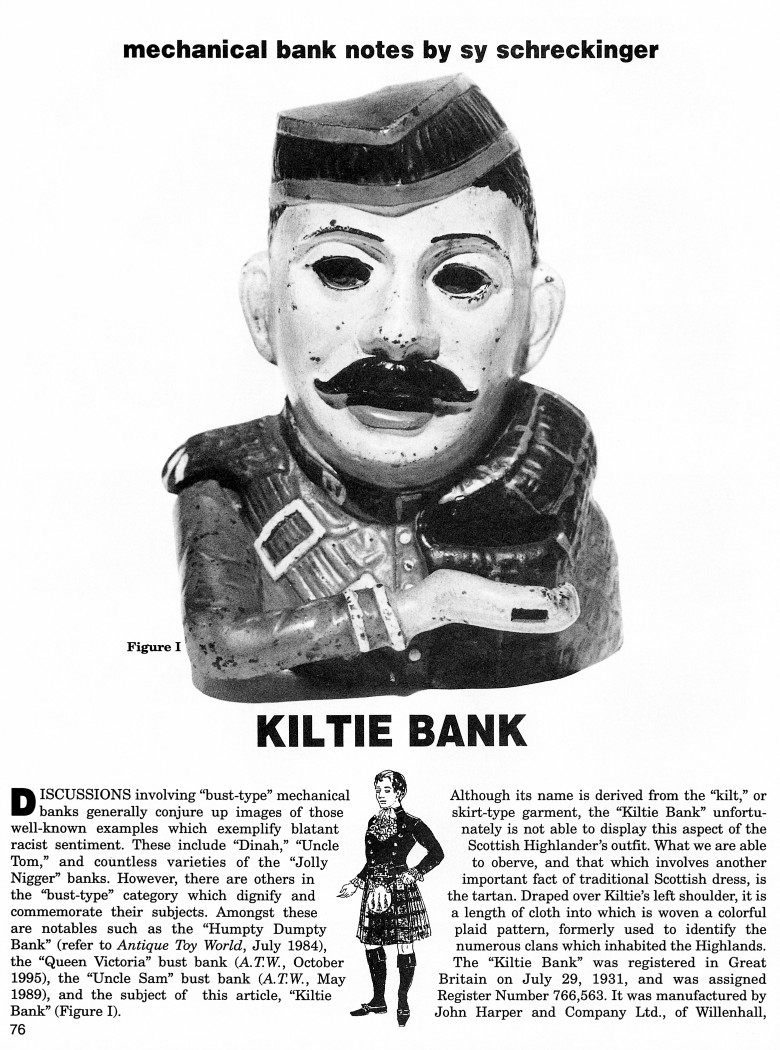|
Kiltie Bank
by Sy Schreckinger – ANTIQUE TOY WORLD Magazine – July, 1996
Discussions involving "bust-type" mechanical banks generally
conjure up images of those well-known examples which exemplify blatant
racist sentiment. These include "Dinah," "Uncle Tom," and countless
varieties of the "Jolly Nigger" banks. However, there are others in the
"bust-type" category which dignify and commemorate their subjects. Amongst
these are notables such as the "Humpty Dumpty Bank" (refer to Antique Toy
World, July 1984), the "Queen Victoria" bust bank (A.T.W.,
October 1995),
the "Uncle Sam" bust bank (A.T.W.,
May 1989), and the subject of this
article, "Kiltie Bank" (Figure I).
Although its name is derived from the "kilt," or skirt-type garment,
the "Kiltie Bank" unfortunately is not able to display this aspect of the
Scottish Highlander's outfit. What we are able to observe, and that which
involves another important fact of traditional Scottish dress, is the
tartan. Draped over Kiltie's left shoulder, it is a length of cloth into
which is woven a colorful plaid pattern, formerly used to identify the
numerous clans which inhabited the Highlands.
The "Kiltie Bank" was registered in Great Britain on
July 29, 1931, and was assigned Register Number 766,563. It was
manufactured by John Harper and Company Ltd., of Willenhall, England, a
well-known and prestigious manufacturer of cast-iron mechanical banks
during the late 19th and early 20th centuries. The quality of castings and
paint application was generally not as fine and detailed as its
counterpart in the United States, i.e., the J. and E. Stevens Company of
Cromwell, Conn. Nonetheless, the design, simplicity, and boldness of
Harper's products speak highly of the company. Figure II is a
representation of an early John Harper catalog featuring several of its
other mechanical banks.
Action of "Kiltie" is uncomplicated and certainly most suggestive of
the Scotsman's penchant for saving money. A coin is placed into our
subject's right hand. As the lever in the rear of the bank is depressed,
the right arm ascends, the eyes roll upward, and the coin slides into the
slot in the tartan. (Note: Only large English pennies will allow for
proper operation.) Deposits are retrieved by unscrewing the baseplate
underneath the bank.
There are no casting or color variations of the "Kiltie Bank." Colors
of the mechanical shown in Figure I are as follows: the face is painted an
overall pink flesh color, with blue eyes; rosy cheeks; black hair,
eyebrows, eyelashes and moustache; and a bright red mouth. The hat is
black with red borders, and the jacket is painted bright red with white
buckles, buttons and embellishments. The tartan is an indigo and red plaid
design. The hand is a pink flesh color, and the raised letters "KILTIE
BANK, RD NO. 766563" on the back of the bank are highlighted in gold.
The "Kiltie Bank" is an appealing and desirable member of the
bust-bank family and is an extremely attractive addition to one's
collection. I am not aware of the existence of any reproductions. If a
bogus example were to surface, it would appear approximately one quarter
of an inch smaller in width, O.D., than indicated in the base diagram
(Figure III).
The superb example of the "Kiltie Bank" (Figure I) is from the
collection of Steve and Marilyn Steckbeck.
|


